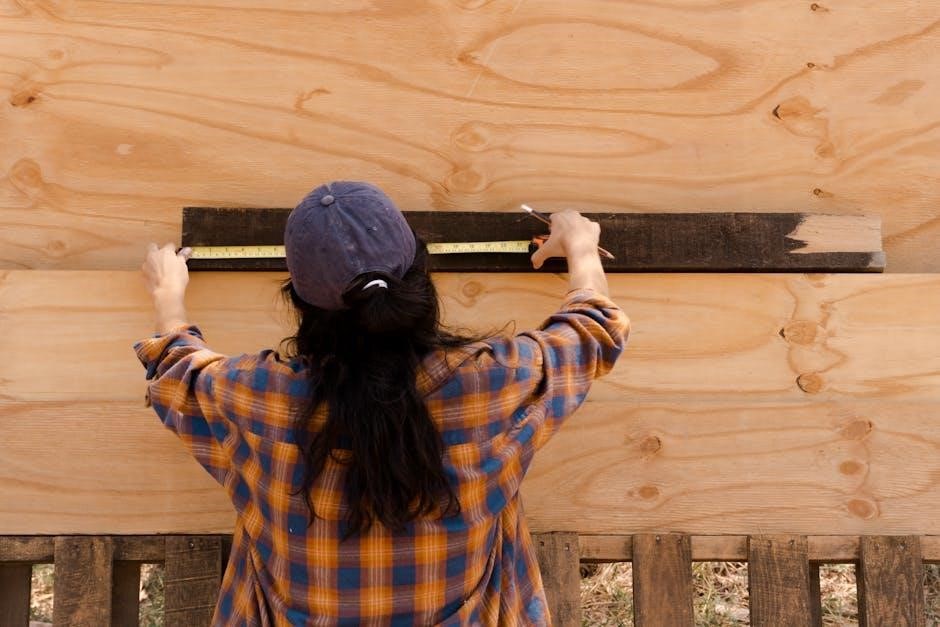Understanding the requirements for safe deck construction is crucial․ The American Wood Council (AWC) offers the “Prescriptive Residential Wood Deck Construction Guide,” a valuable resource․ It simplifies code compliance for single-level decks․

Understanding DCA 6: The Prescriptive Residential Wood Deck Construction Guide
DCA 6, formally known as the “Prescriptive Residential Wood Deck Construction Guide,” is a critical document for anyone involved in building or inspecting residential wood decks․ Published by the American Wood Council (AWC), it provides clear, prescriptive guidance based on the International Residential Code (IRC)․ This guide simplifies complex code requirements, offering straightforward instructions for constructing safe and code-compliant decks․ DCA 6 addresses common deck construction elements and provides tables and illustrations for easy reference․
The guide helps ensure decks meet minimum safety standards․ It is a valuable tool for builders, inspectors, and homeowners alike․ By following DCA 6, one can avoid common pitfalls and ensure the deck is structurally sound and safe for use․ The document covers various aspects of deck construction, from joist sizing and spacing to beam spans and footing requirements․ It also includes information on ledger board attachment, railing construction, and stair design․ DCA 6 is regularly updated to reflect changes in the IRC, so it is important to use the latest version․ The guide is available as a free download from the AWC website, making it easily accessible to anyone who needs it․
By using DCA 6, builders can streamline the construction process and reduce the risk of errors or omissions․ Inspectors can use it as a checklist to verify that decks meet code requirements․ Homeowners can use it to understand the basic principles of deck construction and ensure their decks are built to a high standard․ Overall, DCA 6 is an essential resource for anyone involved in residential wood deck construction, providing clear, concise, and practical guidance to ensure safety and code compliance․ It promotes best practices and helps to create decks that are both beautiful and structurally sound․

Key Elements Covered in DCA 6
DCA 6 comprehensively addresses crucial aspects of deck construction․ Key elements include joists, cantilevers, tension tie-downs, footing options, and glulams․ The guide offers detailed specifications and guidelines for each component, ensuring structural integrity and code compliance․
Joists
Joists are horizontal structural members that support the deck’s surface, distributing the load to the beams and ultimately to the foundation․ DCA 6 provides detailed specifications for joist size, spacing, and span based on the intended load and species of wood used․ Understanding joist spans is crucial for preventing excessive deflection and ensuring a safe and stable deck surface․ The guide includes tables that specify maximum joist spans for various lumber sizes and spacing, taking into account factors such as the type of decking material and the anticipated live load․ Proper joist installation is also emphasized, including the correct fastening methods and ensuring proper bearing on supporting beams or ledgers․ DCA 6 illustrates different joist attachment methods, such as attaching joists to the house ledger and to the side of a beam, or for non-ledger decks․ These illustrations clarify the requirements for proper connection techniques, helping builders achieve structurally sound connections․ Furthermore, the guide addresses the use of joist hangers, which are often necessary for connecting joists to beams or ledgers, providing guidance on selecting the appropriate type and size of joist hanger for the specific application․ Attention to detail in joist selection and installation is paramount for creating a deck that meets code requirements and provides a safe and enjoyable outdoor living space․ Considerations for joist overhangs are also addressed, specifying the maximum allowable overhang based on joist size and spacing․ By adhering to the guidelines provided in DCA 6, builders can ensure that the joists are properly sized, spaced, and installed, resulting in a structurally sound and safe deck that will withstand the test of time․
Cantilevers
Cantilevers, in the context of deck construction, refer to the extension of joists or beams beyond their support points․ DCA 6 provides specific guidelines regarding the allowable length of cantilevers, as excessive cantilevering can compromise the structural integrity of the deck․ The guide outlines the limitations on cantilever length based on the size and spacing of the joists or beams, as well as the anticipated load on the deck․ These limitations are crucial for preventing excessive deflection and ensuring a safe and stable cantilevered section․ DCA 6 emphasizes the importance of properly sizing the joists or beams that support the cantilevered section, taking into account the increased load and stress concentration at the support point․ The guide includes tables and illustrations that demonstrate the proper methods for calculating the allowable cantilever length based on various factors․ Furthermore, DCA 6 addresses the need for adequate support and bracing of cantilevered sections, recommending the use of additional posts or beams to reinforce the structure and prevent excessive movement․ Attention to detail in cantilever design and construction is essential for creating a deck that not only looks aesthetically pleasing but also meets safety standards and provides a reliable outdoor living space․ The guide also clarifies the requirements for connecting the cantilevered section to the main deck structure, ensuring a strong and secure connection that can withstand the forces acting on the cantilever․ By following the guidelines provided in DCA 6, builders can confidently incorporate cantilevers into their deck designs while maintaining structural integrity and safety․ Considerations for decking material and its impact on cantilever performance are also addressed, providing guidance on selecting the appropriate decking material for cantilevered sections; This comprehensive approach ensures that all aspects of cantilever design are carefully considered, resulting in a deck that is both visually appealing and structurally sound․

Tension Tie-Downs
Tension tie-downs are critical components in deck construction, particularly when attaching a deck to a house․ They provide resistance against lateral forces, such as those caused by wind or seismic activity, preventing the deck from pulling away from the house․ DCA 6 outlines specific requirements for tension tie-downs, including their placement, spacing, and connection methods․ The guide emphasizes the importance of using approved connectors that meet specific load capacity requirements․ These connectors must be properly installed to ensure a secure connection between the deck and the house’s structural framing․ DCA 6 provides detailed illustrations and instructions for installing tension tie-downs, including the correct bolt sizes, spacing, and embedment depths․ The guide also addresses the need for proper flashing around the tie-down connections to prevent water intrusion and protect the wood framing from decay․ In addition to resisting lateral forces, tension tie-downs also help to distribute the load of the deck evenly across the house’s foundation․ This is particularly important for decks that are attached to houses with weaker or older foundations․ DCA 6 specifies the minimum load capacity requirements for tension tie-downs based on the size and location of the deck․ The guide also provides guidance on selecting the appropriate type of tie-down for different framing configurations․ By following the guidelines in DCA 6, builders can ensure that their decks are securely attached to the house and can withstand the forces that may act upon them․ The use of tension tie-downs is a critical safety measure that helps to prevent deck collapses and protect the occupants of the house․ Furthermore, DCA 6 clarifies the inspection requirements for tension tie-downs, ensuring that they are properly installed and meet all code requirements․ This helps to ensure that the deck is safe and compliant with local building regulations․ Regular inspection and maintenance of tension tie-downs are also recommended to ensure their continued performance over time․
Footing Options
Footing options are a crucial aspect of deck construction, as they provide the foundation that supports the entire structure․ The Prescriptive Residential Wood Deck Construction Guide (DCA 6) outlines various footing options, each suited to different soil conditions and deck designs․ DCA 6 emphasizes the importance of proper footing size and depth to ensure that the deck can withstand the anticipated loads and environmental factors․ One common footing option is the poured concrete footing, which involves excavating a hole, placing concrete, and then setting a post base or pier on top․ DCA 6 provides guidelines for determining the appropriate size and depth of concrete footings based on the deck’s size, load, and local soil conditions․ Another option is the precast concrete footing, which offers a convenient and time-saving alternative to poured footings․ Precast footings are available in various sizes and shapes, and they can be easily installed by simply excavating a hole and placing the footing in the ground․ DCA 6 specifies the requirements for precast footings, including their load-bearing capacity and resistance to frost heave․ In addition to concrete footings, DCA 6 also addresses the use of helical piles, which are steel shafts with helical blades that are screwed into the ground․ Helical piles are particularly useful in areas with poor soil conditions or where excavation is difficult․ DCA 6 provides guidance on the selection and installation of helical piles, including the required torque and depth to achieve the necessary load capacity․ The guide also emphasizes the importance of ensuring that footings are properly protected from moisture and frost heave․ This can be achieved by using appropriate drainage techniques, such as installing gravel around the footings, and by ensuring that the footings extend below the frost line․ DCA 6 provides detailed illustrations and instructions for constructing footings that meet these requirements․ By following the guidelines in DCA 6, builders can ensure that their decks have a solid and stable foundation that will support the structure for years to come․ The selection of the appropriate footing option is critical to the overall safety and longevity of the deck․
Glulams
Glued laminated timber, commonly known as glulam, represents a sophisticated engineered wood product frequently employed in residential deck construction, particularly when longer spans or heavier load-bearing capabilities are required․ The Prescriptive Residential Wood Deck Construction Guide, often referencing DCA 6, provides essential guidelines for the proper application and specification of glulams in deck designs․ Glulams are manufactured by bonding together individual layers of lumber, known as laminations, using high-strength adhesives․ This process allows for the creation of structural members with significantly greater strength and stiffness compared to conventional solid sawn lumber․ The guide emphasizes that glulams must meet specific performance standards and be manufactured in accordance with recognized industry standards, such as ANSI A190․1, to ensure their structural integrity and reliability․ When incorporating glulams into a deck design, the guide provides tables and formulas for determining the appropriate size and grade of glulam beams based on the anticipated loads, span lengths, and other relevant factors․ These calculations take into account the specific gravity and modulus of elasticity of the wood species used in the glulam, as well as the effects of moisture content and temperature․ The guide also addresses the proper connection details for attaching glulams to supporting posts and other structural members․ These connections must be designed to transfer the full load-carrying capacity of the glulam without causing premature failure or deformation․ Common connection methods include bolting, lag screwing, and the use of specialized metal connectors․ Furthermore, the guide highlights the importance of protecting glulams from moisture exposure, as prolonged exposure to moisture can lead to decay and reduce their structural capacity․ Proper detailing, such as the use of flashing and sealants, is essential to prevent water from penetrating the glulam and causing damage․ The Prescriptive Residential Wood Deck Construction Guide serves as an invaluable resource for builders and designers seeking to utilize the advantages of glulams in their deck projects․ By following the guidelines and recommendations outlined in the guide, one can ensure that glulams are properly specified, installed, and maintained, resulting in a safe and durable deck structure;

Beam Size and Assembly Requirements
Ensuring the correct beam size and proper assembly is paramount in residential wood deck construction․ The “Prescriptive Residential Wood Deck Construction Guide,” often referencing DCA 6, provides detailed specifications for these critical elements, ensuring structural integrity and safety․ Beam size is determined by several factors, including the span of the beam, the load it must support, and the species and grade of wood used․ The guide offers comprehensive tables that correlate these factors, allowing builders to quickly identify the appropriate beam size for their specific project․ These tables typically account for both single and multiple span joist configurations, as well as varying joist overhangs․ The load on the beam is calculated based on the deck’s intended use, including the weight of the decking material, anticipated live loads (people and furniture), and snow loads in applicable regions․ The guide also specifies the allowable stress values for different wood species and grades, which are used to determine the required beam size․ Assembly requirements are equally important, dictating how the beam is connected to supporting posts and other structural members․ Proper connections are essential for transferring loads efficiently and preventing premature failure․ The guide provides detailed illustrations and instructions for various connection methods, including bolting, lag screwing, and the use of metal connectors․ These connections must be designed to resist both vertical loads and lateral forces, such as wind loads․ Furthermore, the guide addresses the spacing and size of fasteners used in beam connections, ensuring that they are adequate to resist the applied forces․ It also emphasizes the importance of using corrosion-resistant fasteners, particularly in coastal environments or when treated lumber is used․ In addition to connection details, the guide also specifies requirements for beam bearing, ensuring that the beam is adequately supported at its ends․ Proper bearing prevents crushing of the wood fibers and ensures that the load is distributed evenly to the supporting structure․ The “Prescriptive Residential Wood Deck Construction Guide” serves as an indispensable tool for builders and designers, providing clear and concise guidance on beam size and assembly requirements․ By adhering to these specifications, one can ensure that the deck is structurally sound and capable of withstanding the anticipated loads, providing a safe and enjoyable outdoor living space for years to come․